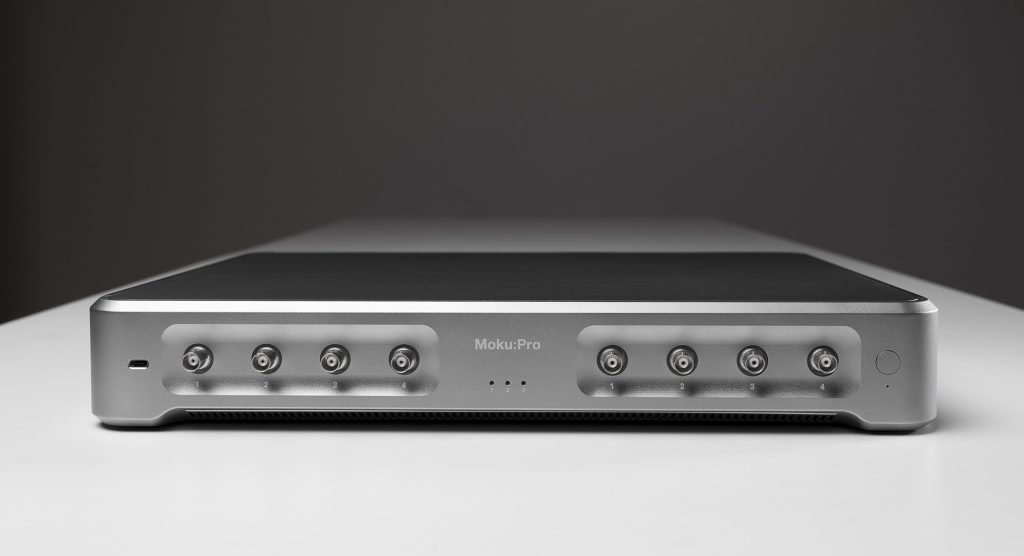As a leader in precision software-defined instrumentation, Liquid Instruments is revolutionizing the way that scientists, engineers, and students discover, create, and learn.
Interview with Daniel Shaddock, CEO of Liquid Instruments.
Easy Engineering: Please give a brief description of the company and its activities.
Daniel Shaddock: We’re a forward-thinking company with a mission to create transformational test and measurement solutions that give our users new ways to improve efficiency, workflow, and capabilities in the lab. We’re a global team with offices in Canberra, Australia, and San Diego, California, with additional team members in Asia and Europe. Ultimately, our vision is to deliver unmatched test solutions to help engineers and scientists build technology that solves the world’s greatest challenges. Our Moku family of products leverages the computational power of field-programmable gate arrays (FPGAs) and the flexibility of software to deliver highly versatile instrumentation for acquiring and analyzing data, generating complex waveforms, and implementing closed-loop control systems. Inside each Moku device is a powerful FPGA that allows it to be reconfigured into whatever instrument the user chooses, instantly. Now users can quickly access 12+ software-defined instruments — from test essentials like an oscilloscope and spectrum analyzer to advanced tools like a lock-in amplifier and laser lock box — with a single device at a fraction of the cost. When using a Moku device, users simply select an instrument to launch and start taking measurements.
E.E: What are the main areas of activity of the company?
D.S: Most players in the test and measurement industry continue to focus on developing conventional hardware, which often consists of bulky, expensive boxes designed to perform one function. This outdated model has given us a unique opportunity to lead a long-overdue transition in the industry, moving from standalone hardware to flexible, software-centric tools and equipment. Software-defined instrumentation provides a more dynamic, flexible, affordable, and efficient test solution for engineers, scientists, and professors. With our revolutionary Moku products, users in a wide variety of industries, from aerospace and defense to semiconductor and education, can now access and use multiple instruments simultaneously from one device, easily integrate functions to perform complex tests, and add more functionality to their equipment through software upgrades as their needs evolve. We release software updates regularly, and make them available to our users with a simple download, similar to upgrading the software periodically on a smartphone. Unlike traditional fixed-function hardware, our software-first approach means that all Moku devices get better with new features and capabilities over time.

E.E: What’s the news about new products?
D.S: All Moku products feature highly intuitive software that is easily upgradable, allowing users to access the latest enhancements with a quick download. Instead of constantly having to purchase expensive new test tools to keep up with the changing pace of technology, our users can leverage more than 12 next-generation instruments in one compact hardware device. Since Moku products are so flexible, they can easily accommodate our users’ specific needs in one experiment and seamlessly expand their functionality later across additional experiments or use cases. Compared with traditional equipment designed for on-site use, software-centric Moku devices are engineered to be network connected, allowing for easy data sharing between multiple systems and users — a crucial capability for efficient collaboration across distributed teams. Our latest software upgrade, Moku Version 3.0, has unified the software experience across all of our hardware devices. It has also improved code portability across devices, while enhancing development efficiency to speed up future feature releases. With the latest updates, users also gained instant access to dozens of exciting new instrument features to accelerate development timelines, minimize costs, and optimize their workflows. For example, Moku:Lab users gained access to Multi-instrument Mode, which allows them to use two instruments simultaneously, as well as Moku Cloud Compile, a feature that enables them to quickly write and deploy VHDL code to deploy custom features. We made these upgraded capabilities available to all Moku:Lab users at no additional charge, just a simple software download — underscoring our commitment to developing software-defined test and measurement solutions that get better over time.
E.E: What are the ranges of products?
D.S: The Moku platform for software-defined instrumentation is available on three versatile hardware options: Moku:Pro for technology development, Moku:Lab for research, and Moku:Go for a portable design and test solution. Moku:Pro is a novel software-defined test and measurement device designed for the most demanding research and engineering applications. It delivers a breakthrough combination of performance and flexibility through sophisticated, FPGA-based architecture. The device integrates an entire suite of professional-grade instruments tailored for data acquisition and real-time control. The Moku:Pro PID Controller instrument features an intuitive frequency domain user interface that allows direct manipulation and visualization of the controller response. Users can even run up to four instruments simultaneously and deploy their own real-time signal processing. With low-latency, lossless digital connections between instruments, Moku:Pro provides a complete, customizable control solution. Moku:Lab, our original product, combines the digital signal processing power of a reconfigurable FPGA with robust analog inputs and outputs. Users gain access to a full suite of powerful scientific instruments and advanced customization capabilities to level up their workflow in the lab. Moku:Lab helps the world’s brightest minds in cutting-edge labs from industry, government, and education to measure more with less, replacing multiple pieces of equipment with a single device at a fraction of the cost. Finally, Moku:Go is our tool for engineers, scientists, and students that need reliable test equipment they can take anywhere. Our most cost-effective option, Moku:Go is a flexible, portable design and analysis tool to advance teaching and commercial test. Moku:Go features a full suite of instruments and power supplies, and — similar to Moku:Pro and Moku:Lab — the ability to run custom code, and API support, all in one portable, convenient solution that allows users to test from anywhere, with advanced capabilities unavailable from any other device in its class.

E.E: At what stage is the market where you are currently active?
D.S: While T&M is a mature market, we’re just beginning to tap into the global potential with regard to software-defined instrumentation. We recently announced strategic global expansion efforts following three years of 100% annual growth, including an expanded Authorized Distributor Program. By teaming up with strategic partners around the world, we can support more end users from prominent and renowned institutions, including Humboldt University of Berlin, the University of Glasgow, and others, while ensuring that they are supported regionally by experienced and innovative companies committed to their success. From additional resources and tools to dedicated support and joint marketing opportunities, the program provides partners with more ways to expand their businesses with Moku products, accelerate their growth, and provide exceptional customer experiences. Beyond our partner program, we’ve also seen recent sales growth in 41 total countries, adding 11 of those countries in just the past few months.
E.E: What can you tell us about market trends?
D.S: Ongoing supply chain disruptions are opening more possibilities for scientists and engineers to embrace software-defined instrumentation. With flexible products like Moku in their labs, they no longer have to rely on multiple, single-function products with extremely long lead times. The higher levels of integration enabled by software-defined instrumentation will also help simplify asset management and end-of-life challenges for legacy equipment. Simply put, software will continue to grow in importance in the test industry. Computing devices are everywhere, and people have come to expect seamless digital experiences. In the lab, software enables incredible agility with cumulative benefits. Algorithms don’t degrade over time. Looking ahead, these capabilities will become even more sophisticated, powerful, and capable. It’s an exciting time for test and measurement.
E.E: What are the most innovative products marketed?
D.S: All Moku devices are on the leading edge of technical innovation — they offer an entire test bench of instrumentation in one device integrated with flexible software. One recent innovation that we’re excited about is the compatibility of ChatGPT with our family of Moku devices using a feature called Moku Cloud Compile. This revolutionary feature allows users to run custom logic on a Moku device’s FPGA with no specialized tools or know-how required. With Moku Cloud Compile, users can deploy custom VHDL code that runs alongside existing instruments, enabling custom features and unlocking new instrumentation through innovative Instrument-on-Chip architecture. This feature is particularly useful for advanced experiments or product design initiatives with unique requirements. Unlike traditional equipment, user-programmable FPGAs provide higher-performance solutions that can add custom functionality to an instrument and interact with real-world signals in real time. This integration creates tremendous new opportunities for researchers, engineers, and scientists to further explore the limits of what is possible with Moku devices. It lowers the barrier to entry for VHDL coding, enabling users to generate custom FPGA code that is deployable to Moku devices without needing any prior knowledge of digital logic design or programming. It also speeds up testing and allows for faster deployment of custom code to real-world hardware, meaning that users can accelerate their development timelines and optimize their workflow, saving them valuable time and resources. Overall, the interoperability between Moku devices and ChatGPT means that users can push the boundaries in a range of applications, from quantum optics to medical imaging to electronics design, and ultimately achieve new breakthroughs faster in their fields. Since this integration makes FPGA coding more accessible to users with limited digital logic design or programming backgrounds, it further democratizes test and measurement, and will lead to more breakthroughs for our users.

E.E: What estimations do you have for 2023?
D.S: Looking at this year and beyond, software-defined instrumentation will continue making test workflows in a range of applications more efficient while helping users meet increasing business pressures to control costs and get their products to market faster. It will also enable greater innovation for users who are pushing the boundaries in emerging or specialized test applications, which means more test and measurement niches can be served economically and efficiently. The Laser Lock Box instrument for Moku devices is one example of how software-defined instrumentation better supports specialized markets like optics and photonics. Until recently, most users would have to build a laser locking system themselves by cobbling different components together, but with software-defined instrumentation, this instrument is easily affordable and accessible from one device. As the capabilities and advantages of FPGAs continue to grow, and the speed of improvement gets better, the technology will reach higher into the most valuable parts of the market. FPGAs will run much more quickly, with more memory, higher frequencies, and greater processing power. FPGAs are inherently parallel, and with more transistors, users will be able to do more, faster. The dynamism of FPGA reconfigurability will continue to increase, blurring the line between hardware and software. We’re thrilled to lead this evolution and we look forward to bringing the benefits of software-defined instrumentation to even more users around the world.

